I really need to keep my brain busy these days (those who know me know why), and writing a new blog on particle physics is one of the available ways that I found to achieve this.
The topic that I picked concerns hypothetical particles called leptoquarks (I will define this term in a moment; please give me a few lines), and this blog is therefore a simple pretext to shed some light on one of my recent research articles. In this paper, with collaborators we investigated novel mechanisms yielding the production of those leptoquarks at particle colliders like CERN’s Large Hadron Collider (the LHC), and achieved the calculation of associated predictions.
If you are interested in leptoquarks, a good way to learn more about them would be to check this older blog. However, as I like to write self-consistent posts, a (kind of) short introduction is provided below too. In addition, I discuss in the following how leptoquarks are searched for at particle colliders, and what are the novelties in the publication to which this blog is dedicated.
For those pushed for time, you can always skip the rest of the text entirely. The main message is available from the last section of the post that consists of a “TL; DR’ version of it.
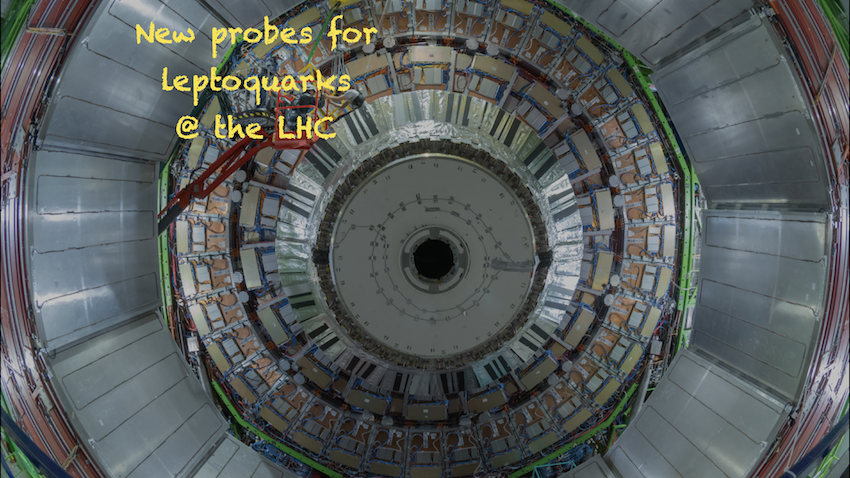
[Credits: Original image from Noemi Caraban Gonzalez (CERN)]
Leptoquarks? The new kids on the block!
This post is all about leptoquarks. Therefore, a good starting point would be a definition. Let’s go with it!
The Standard Model of particle physics contains several classes of fundamental building blocks of matter: quarks and leptons. The former are sensitive to the strong interaction (one of the four fundamental forces) whereas the latter are not.
That’s the main difference between them, and it leads to an important feature: quarks form bound states that further give rise to atomic nuclei at a larger scale, while leptons don’t (see this blog for more information on that topic). In particular, quarks include up and down quarks (that can be combined into protons and neutrons), and examples of leptons include electrons, muons and neutrinos.
In the Standard Model, quarks interact among themselves in three ways: through the strong force, the weak force and electromagnetically. On the other hand, leptons only interact via the weak and electromagnetic force. A similar story holds for the quark and lepton interactions with the Higgs boson (see here for more information on this beast). There is thus no Standard Model interaction involving simultaneously one quark and one lepton.
We can question the reason behind this. Why can’t we have interactions involving one lepton and one quark? Furthermore, we can also ask the opposite question. Why should we need a specific interaction involving one quark and one lepton? After all, there is no hint for such an interaction in all high-energy physics data of the last hundreds years.
So we have a puzzle…
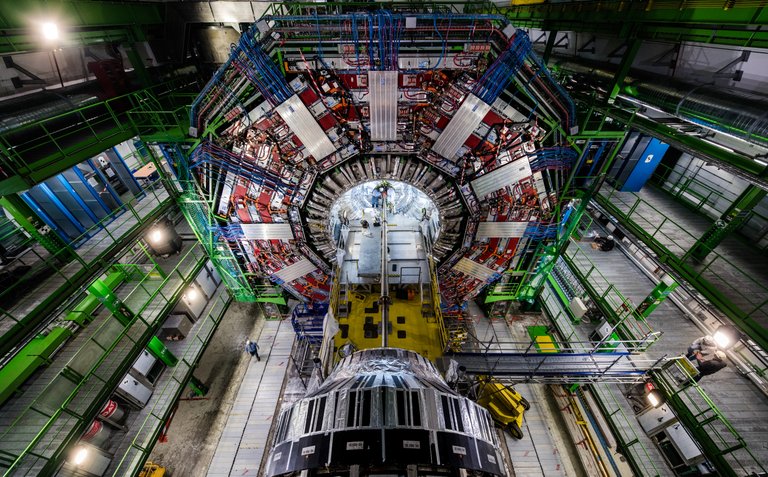
[Credits: Maximilien Brice (CERN)]
In order to find a way out, it is good to remember that physicists have always tried to find the most elegant description of nature. Even with a Standard Model of particle physics that works so well, there is good motivation to go beyond it (see here for more information). The quest for a more elegant framework for the dynamics of the fundamental particles is thus still a very active one.
In this quest for new phenomena, one option is to unify all fundamental interactions and make them the three facets of a unique force. Or at least, we can try to do so without violating any observation. Playing this game is referred to as building a Theory of Grand Unification.
One interesting consequence of such Grand Unified Theories is that they feature new particles that interact simultaneously with one quark and one lepton. These are coined leptoquarks. Here is the long-awaited definition!
It must also be emphasised that leptoquarks are also present in various other theories beyond the Standard Model, and that they are prime candidates to explain a few anomalies in data (see for instance this older blog). Leptoquarks are thus well motivated beasts, and therefore actively searched for in data by experimenters.
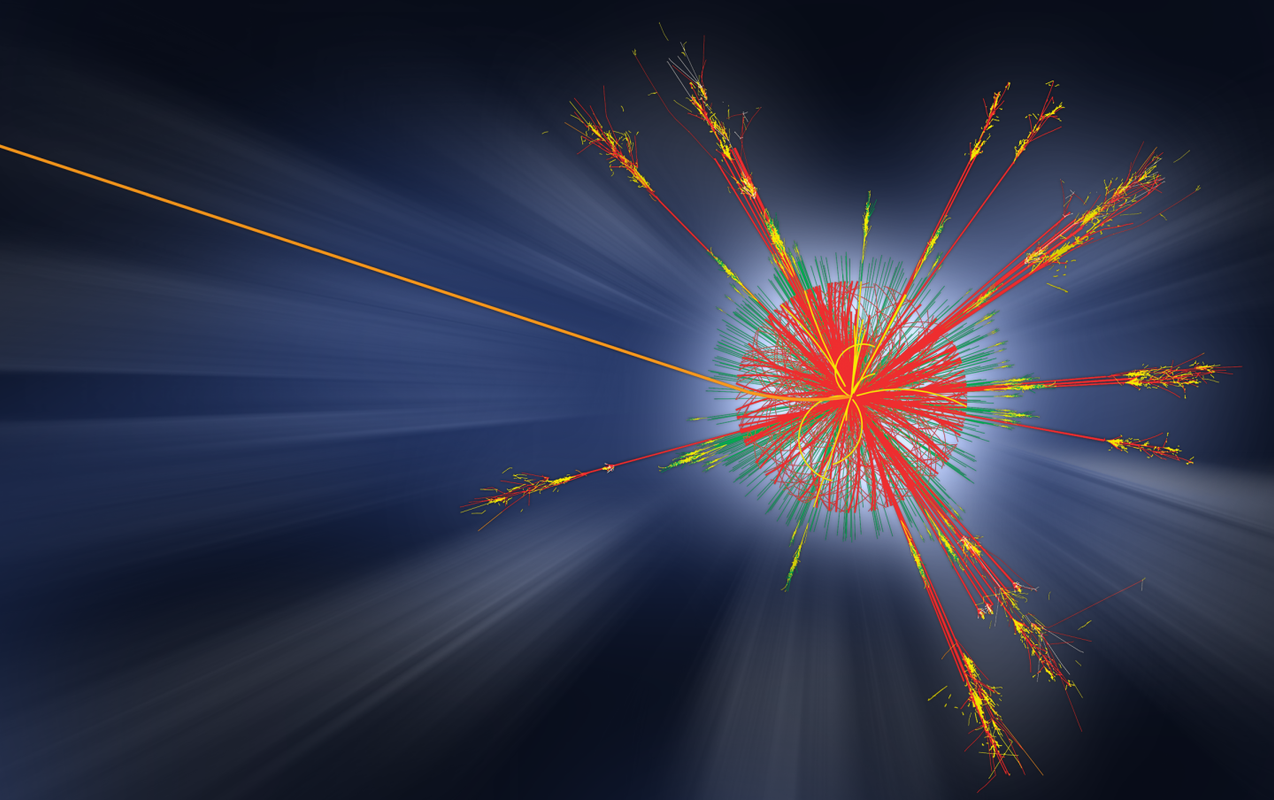
[Credits: ATLAS @ CERN]
Leptoquark signals at CERN’s Large Hadron Collider
The next 10,000 HBD question is about how to search for leptoquarks? In the following, I will give some insights on the answer to that, from the particle collider point of view.
As written above, a leptoquark couples to one quark and one lepton. Therefore, once produced, a leptoquark decays into one quark and one lepton. So, what to do with this property?
Let’s imagine that one leptoquark is produced at CERN’s Large Hadron Collider. Then, it immediately decays into one quark and one lepton, which defines a possible leptoquark signal. Now let’s imagine that this time a pair of leptoquarks are produced. Then, their decay gives rise to two quarks and two leptons. This defines a second generic signature of leptoquarks at colliders.
Most LHC searches for leptoquarks target their pair production and decay (the corresponding rates being generally larger). This yields a large set of potential leptoquark signatures to consider. As there are six quarks and six leptons in the Standard Model, there are many available options (all possible combinations of two leptons and two quarks). Unfortunately, experimental resources are limited, so that only a few signatures are investigated. In addition, some searches target leptoquark single production. Their sensitivity is however weaker.
All these searches give strong bounds on leptoquarks, but also a lot of freedom for leptoquark signals to evade the constraints (due to the non-considered channels in the experimental analyses). In all the searches, the leptoquark signals are however expected to originate from the pair-production of one a single leptoquark species.
Is it a reasonable assumption? The publication on which this blog focuses shows that it is not the case, and it gives insights on what could be done better for signal modelling.
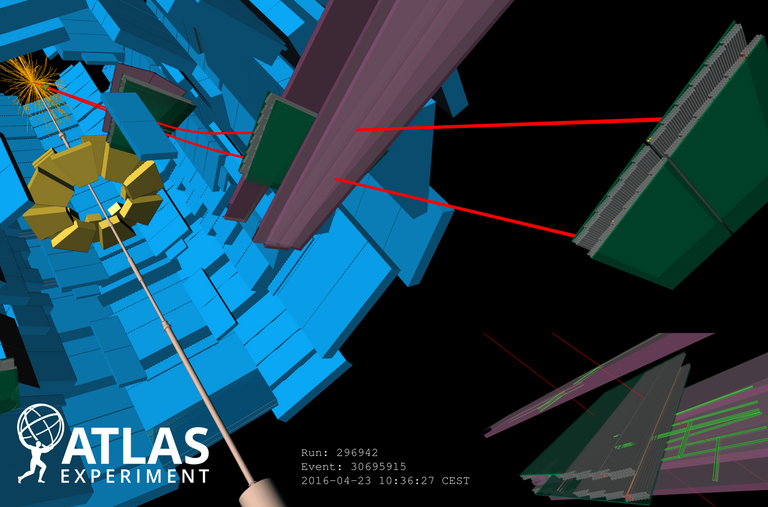
[Credits: ATLAS @ CERN]
Leptoquarks and anomalies in data
The Standard Model of particle physics includes a feature called lepton flavour universality. This means that if we take a process that leads to the production of any pair of leptons (for instance a pair of electrons, a pair of muons or a pair of taus), all related observations should be independent of the kind of leptons involved.
This comes from the fact that the only difference between the three types of leptons is their mass, and that these masses are all small (compared with the typical energy scale of a high-energy physics process). In other words, the mass difference between all leptons can barely yield any observable effect.
However, some recent measurements point to hints for lepton flavour universality violations. One possible way to restore agreement between data and theory is then to add leptoquarks to the Standard Model. Note the plural form: several leptoquarks and not a single leptoquark.
This leads to one important question relative to experimental searches for leptoquarks at the LHC: what is the impact of including several leptoquarks in the theoretical framework, instead of a single one? Should this affect the sensitivity of the LHC to leptoquarks?
This is what my collaborators and I have tried to address quantitatively, and in a precise manner (that's the real novelty of our work).
Let’s assume that we take a model motivated by an explanation to the current anomalies observed in data. Then, we must consider a model with a small set of leptoquarks (two to five for instance). In this case, it becomes possible to produce a pair of each leptoquark of the set, but also any combination of two different leptoquarks.
It is now time to focus on my publication and discuss one of its figures.
New mechanisms to produce leptoquarks at the LHC
The figure I have chosen is the one shown below. It discusses leptoquark pair production in the case of a model featuring 5 different leptoquarks. Such a model is favoured by the observed anomalies.
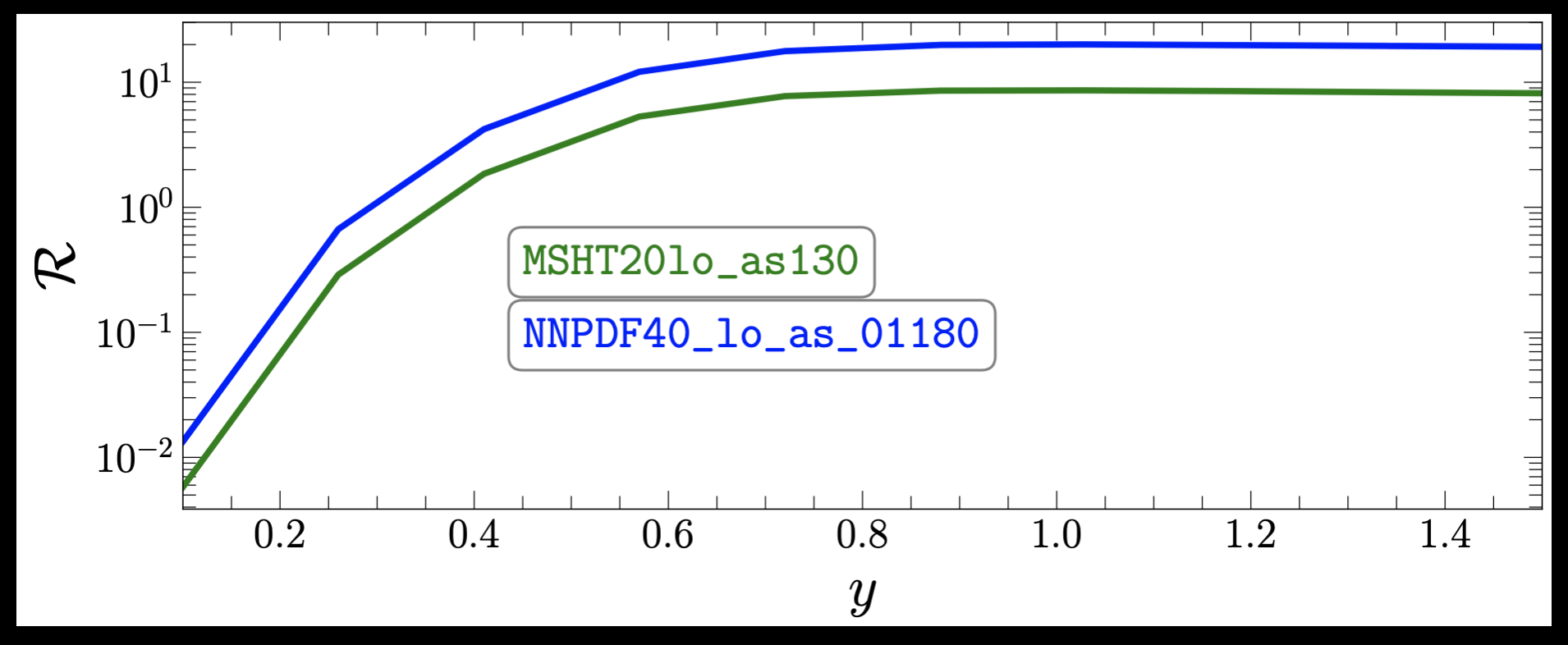
[Credits: arXiv:2207.02879 [hep-ph]]
What do we see in this figure?
First, let’s focus on the X-axis. This is the strength of the leptoquark coupling to a lepton and a quark. The bigger it is, the stronger the leptoquark is coupled. On the Y-axis, we introduce a quantity called R that is the ratio between the rate associated with the production of two different leptoquarks, to the rate associated with the production of two identical leptoquarks. I recall that only the latter is considered in LHC searches.
We see that for small y values, this ratio R is small. This means that leptoquark production is dominated by the production of a pair of two identical leptoquarks. At larger y values, this ratio increases significantly. This means that leptoquark production gets dominated by the production of two different leptoquarks.
It is a good moment to mention that anomalies are explained only if the value of y is large. We are thus in a situation where the production of different leptoquarks dominates, which contrasts with the hypothesis taken in experimental studies. The most important signals of motivated scenarios are thus just not searched for optimally.
This leads to a few questions. To which extent current searches for leptoquarks at the LHC really constrain favoured scenarios (signal rates being underestimated)? How could the sensitivity be increased by considering the signatures coming from the production of a pair of different leptoquarks? For now, we have no answer to these questions, although it is clear that there is an impact. We are working on it. Stay tuned!
I finish this discussion with a remark on the above figure. It includes two curves, a blue one and a green one. The difference between them comes from the manner to relate a proton to its content. This is critical because a high-energy proton-proton collision is in fact a scattering process of two of the constituents of the colliding protons, as detailed in this blog.
The blue and green curves correspond to two ways to link the protons to their content. We see that they disagree… This means that there is something important to learn here, and that knowledge still has some room to advance!
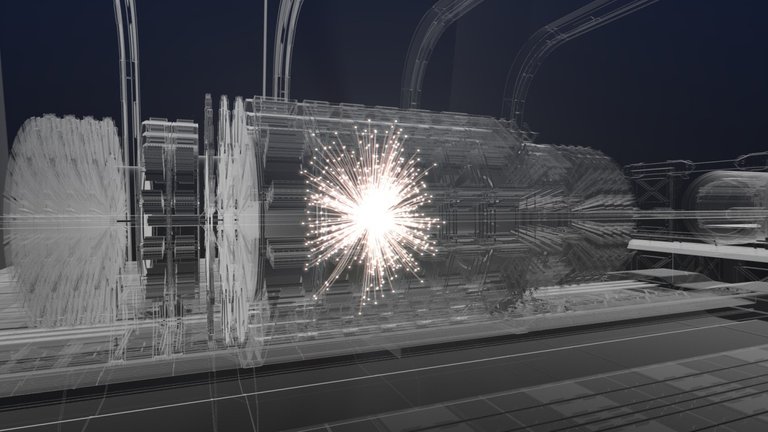
[Credits: CERN]
Summary: leptoquarks and new way to seek them at the LHC
Leptoquarks are hypothetical particles that interact simultaneously with one lepton and one quark of the Standard Model. As we have six leptons and six quarks, this gives numerous (actually 36) possibilities for these interactions. Moreover, leptoquarks are predicted by many theories aiming at curing some of the practical and conceptual limitations of the Standard Model, and they consist of prime candidates to explain some anomalies seen in high-energy physics data.
As a consequence, leptoquarks are actively searched for at the LHC. Taking their quark-lepton coupling into account, a typical leptoquark signal at the LHC originates from the production of one or two leptoquarks, followed by their decay. So far, most searches conducted by the ATLAS and CMS collaborations consider the production of a pair of identical leptoquarks that then decay into the same lepton+quark final state. This gives a signal that is made of two quarks and two leptons.
All measurements are currently compatible with the Standard Model background (i.e. the production of the same final state from Standard Model particles only), so that the results of the searches lead to strong constraints on the viability of leptoquark models.
However, these searches do not capture optimally the leptoquark signals of scenarios in which leptoquarks cure the anomalies seen in data. In this case, the theory should include several leptoquarks, and we should consider the production of both a pair of identical leptoquarks and a pair of different leptoquarks.
This is the possibility that I have investigated with my collaborators in one of my latest publications. We have demonstrated that the bulk of the leptoquark signal comes from the production of two different leptoquarks, and that the corresponding LHC signatures are actually not searched for.
To rewrite this shortly: we may not exploit the machine in the best potential way. We are currently extending our study, trying to be more quantitative relative to the last statement. However, this will be the topic of another blog. We first need to finish our study ;)
I stop here for today, and I hope you enjoyed this post about leptoquarks. Feel free to leave me comments, suggestions and feedback in the comment section of this blog. Engagement is always appreciated!





